Chengkai Han
Bridging Traffic State and Trajectory for Dynamic Road Network and Trajectory Representation Learning
Feb 08, 2025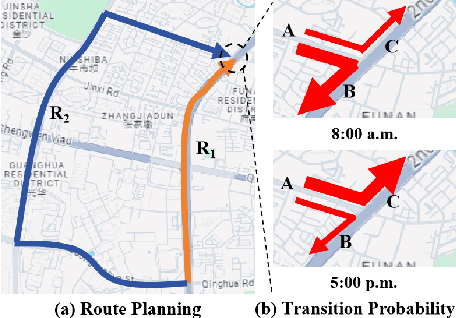

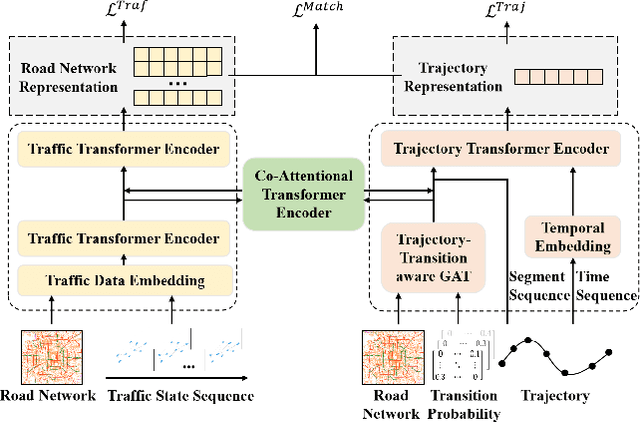

Abstract:Effective urban traffic management is vital for sustainable city development, relying on intelligent systems with machine learning tasks such as traffic flow prediction and travel time estimation. Traditional approaches usually focus on static road network and trajectory representation learning, and overlook the dynamic nature of traffic states and trajectories, which is crucial for downstream tasks. To address this gap, we propose TRACK, a novel framework to bridge traffic state and trajectory data for dynamic road network and trajectory representation learning. TRACK leverages graph attention networks (GAT) to encode static and spatial road segment features, and introduces a transformer-based model for trajectory representation learning. By incorporating transition probabilities from trajectory data into GAT attention weights, TRACK captures dynamic spatial features of road segments. Meanwhile, TRACK designs a traffic transformer encoder to capture the spatial-temporal dynamics of road segments from traffic state data. To further enhance dynamic representations, TRACK proposes a co-attentional transformer encoder and a trajectory-traffic state matching task. Extensive experiments on real-life urban traffic datasets demonstrate the superiority of TRACK over state-of-the-art baselines. Case studies confirm TRACK's ability to capture spatial-temporal dynamics effectively.
Unified Data Management and Comprehensive Performance Evaluation for Urban Spatial-Temporal Prediction [Experiment, Analysis & Benchmark]
Aug 24, 2023![Figure 1 for Unified Data Management and Comprehensive Performance Evaluation for Urban Spatial-Temporal Prediction [Experiment, Analysis & Benchmark]](/_next/image?url=https%3A%2F%2Ffigures.semanticscholar.org%2F1fd6f33f6429b248e983193d2278ab3e1814471c%2F2-Figure1-1.png&w=640&q=75)
![Figure 2 for Unified Data Management and Comprehensive Performance Evaluation for Urban Spatial-Temporal Prediction [Experiment, Analysis & Benchmark]](/_next/image?url=https%3A%2F%2Ffigures.semanticscholar.org%2F1fd6f33f6429b248e983193d2278ab3e1814471c%2F3-Table1-1.png&w=640&q=75)
![Figure 3 for Unified Data Management and Comprehensive Performance Evaluation for Urban Spatial-Temporal Prediction [Experiment, Analysis & Benchmark]](/_next/image?url=https%3A%2F%2Ffigures.semanticscholar.org%2F1fd6f33f6429b248e983193d2278ab3e1814471c%2F4-Figure2-1.png&w=640&q=75)
![Figure 4 for Unified Data Management and Comprehensive Performance Evaluation for Urban Spatial-Temporal Prediction [Experiment, Analysis & Benchmark]](/_next/image?url=https%3A%2F%2Ffigures.semanticscholar.org%2F1fd6f33f6429b248e983193d2278ab3e1814471c%2F4-Table2-1.png&w=640&q=75)
Abstract:The field of urban spatial-temporal prediction is advancing rapidly with the development of deep learning techniques and the availability of large-scale datasets. However, challenges persist in accessing and utilizing diverse urban spatial-temporal datasets from different sources and stored in different formats, as well as determining effective model structures and components with the proliferation of deep learning models. This work addresses these challenges and provides three significant contributions. Firstly, we introduce "atomic files", a unified storage format designed for urban spatial-temporal big data, and validate its effectiveness on 40 diverse datasets, simplifying data management. Secondly, we present a comprehensive overview of technological advances in urban spatial-temporal prediction models, guiding the development of robust models. Thirdly, we conduct extensive experiments using diverse models and datasets, establishing a performance leaderboard and identifying promising research directions. Overall, this work effectively manages urban spatial-temporal data, guides future efforts, and facilitates the development of accurate and efficient urban spatial-temporal prediction models. It can potentially make long-term contributions to urban spatial-temporal data management and prediction, ultimately leading to improved urban living standards.
Towards Efficient and Comprehensive Urban Spatial-Temporal Prediction: A Unified Library and Performance Benchmark
Apr 29, 2023



Abstract:As deep learning technology advances and more urban spatial-temporal data accumulates, an increasing number of deep learning models are being proposed to solve urban spatial-temporal prediction problems. However, there are limitations in the existing field, including open-source data being in various formats and difficult to use, few papers making their code and data openly available, and open-source models often using different frameworks and platforms, making comparisons challenging. A standardized framework is urgently needed to implement and evaluate these methods. To address these issues, we provide a comprehensive review of urban spatial-temporal prediction and propose a unified storage format for spatial-temporal data called atomic files. We also propose LibCity, an open-source library that offers researchers a credible experimental tool and a convenient development framework. In this library, we have reproduced 65 spatial-temporal prediction models and collected 55 spatial-temporal datasets, allowing researchers to conduct comprehensive experiments conveniently. Using LibCity, we conducted a series of experiments to validate the effectiveness of different models and components, and we summarized promising future technology developments and research directions for spatial-temporal prediction. By enabling fair model comparisons, designing a unified data storage format, and simplifying the process of developing new models, LibCity is poised to make significant contributions to the spatial-temporal prediction field.
BUAA_BIGSCity: Spatial-Temporal Graph Neural Network for Wind Power Forecasting in Baidu KDD CUP 2022
Feb 22, 2023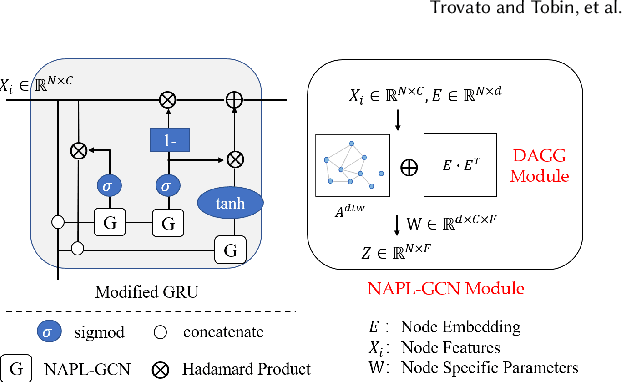

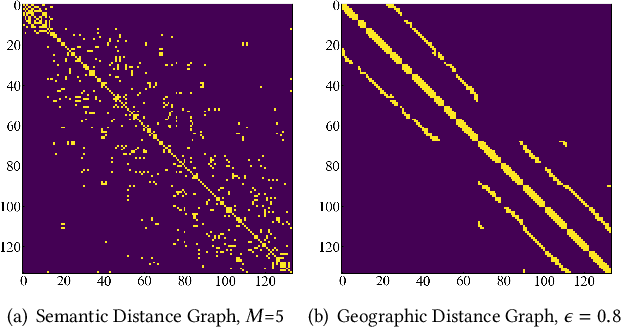
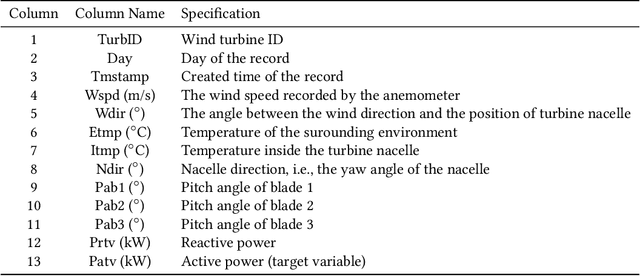
Abstract:In this technical report, we present our solution for the Baidu KDD Cup 2022 Spatial Dynamic Wind Power Forecasting Challenge. Wind power is a rapidly growing source of clean energy. Accurate wind power forecasting is essential for grid stability and the security of supply. Therefore, organizers provide a wind power dataset containing historical data from 134 wind turbines and launch the Baidu KDD Cup 2022 to examine the limitations of current methods for wind power forecasting. The average of RMSE (Root Mean Square Error) and MAE (Mean Absolute Error) is used as the evaluation score. We adopt two spatial-temporal graph neural network models, i.e., AGCRN and MTGNN, as our basic models. We train AGCRN by 5-fold cross-validation and additionally train MTGNN directly on the training and validation sets. Finally, we ensemble the two models based on the loss values of the validation set as our final submission. Using our method, our team \team achieves -45.36026 on the test set. We release our codes on Github (https://github.com/BUAABIGSCity/KDDCUP2022) for reproduction.
PDFormer: Propagation Delay-aware Dynamic Long-range Transformer for Traffic Flow Prediction
Jan 19, 2023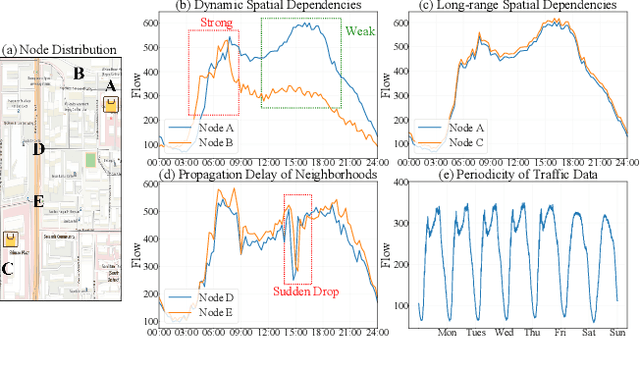

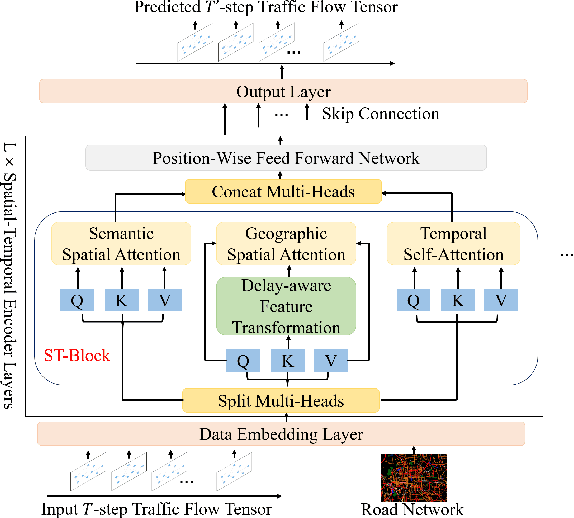
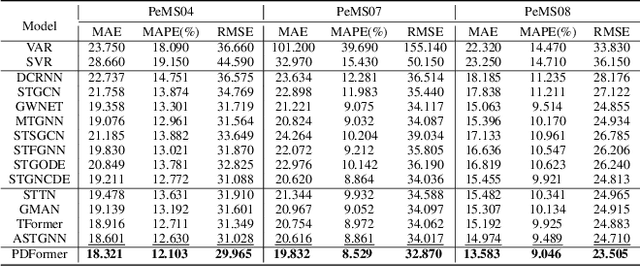
Abstract:As a core technology of Intelligent Transportation System, traffic flow prediction has a wide range of applications. The fundamental challenge in traffic flow prediction is to effectively model the complex spatial-temporal dependencies in traffic data. Spatial-temporal Graph Neural Network (GNN) models have emerged as one of the most promising methods to solve this problem. However, GNN-based models have three major limitations for traffic prediction: i) Most methods model spatial dependencies in a static manner, which limits the ability to learn dynamic urban traffic patterns; ii) Most methods only consider short-range spatial information and are unable to capture long-range spatial dependencies; iii) These methods ignore the fact that the propagation of traffic conditions between locations has a time delay in traffic systems. To this end, we propose a novel Propagation Delay-aware dynamic long-range transFormer, namely PDFormer, for accurate traffic flow prediction. Specifically, we design a spatial self-attention module to capture the dynamic spatial dependencies. Then, two graph masking matrices are introduced to highlight spatial dependencies from short- and long-range views. Moreover, a traffic delay-aware feature transformation module is proposed to empower PDFormer with the capability of explicitly modeling the time delay of spatial information propagation. Extensive experimental results on six real-world public traffic datasets show that our method can not only achieve state-of-the-art performance but also exhibit competitive computational efficiency. Moreover, we visualize the learned spatial-temporal attention map to make our model highly interpretable.
 Add to Chrome
Add to Chrome Add to Firefox
Add to Firefox Add to Edge
Add to Edge